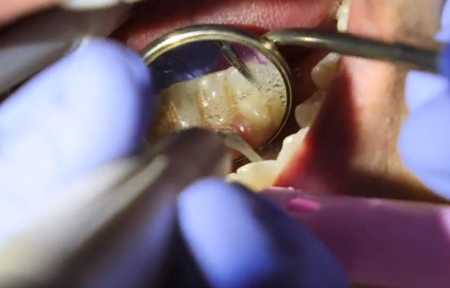Tartar forms on teeth very slowly, but constantly. You have to watch for it and remove the tartar in time.
With irregular or improper oral hygiene, plaque builds up on your teeth and becomes hard over time. This is tartar, and it can cause a lot of problems. Solid formations not only spoil the appearance of your teeth, but also cause bad odor from your mouth. In addition, without removing the pathogenic plaque, serious diseases may soon develop.
Causes
In addition to a lack of regular oral hygiene, there are other reasons why tartar forms:
- The use of low-quality toothpaste and brushes;
- Impaired metabolic function in the body;
- Inadequate intake of solid foods;
- Increased viscosity of saliva;
- presence of diseased teeth or missing multiple teeth in the patient’s mouth;
- smoking;
- Consumption of large quantities of sweet foods and foods high in carbohydrates;
- Unbalanced diet;
- Chewing food on one side (e.g., only the right side);
- Prolonged use of broad-spectrum antibiotics;
- Increased roughness of tooth enamel after a filling or orthodontic treatment;
- Consumption of foods with many chemical additives such as flavorings, colorings, sweeteners, etc.
The risk group includes people with a bad bite, crowded teeth, smokers and patients who ignore the rules of personal hygiene.
Important! There are two kinds of tartar – supragingival and subgingival. Both of them require medical attention because it is impossible to remove hard dental plaque at home without damaging the tooth.
Why Tartar Is Bad?
The danger of tartar is that it keeps growing and affects both soft and hard tissues. If it is not removed, serious health problems await the patient.
Tartar is a pathogenic entity that causes inflammation in the surrounding structures. Inflamed gum tissues begin to bleed even when lightly touched, and soon a severe form of gingivitis develops.
A steady buildup of tartar and its deepening into the gingival space leads to dental root damage from hard deposits and the destruction of the apparatus tissue that supports the teeth.
Over time, the affected bone tissues cease to perform their functions, and periodontal pockets form. When food gets into them, over time, inflammation begins and periodontitis occurs. The disease affects all tissues surrounding the affected tooth and progresses rapidly without treatment.
In addition, prolonged pathological processes in the oral cavity can cause diseases of the gastrointestinal tract.
How to Remove Tartar Fast
Tartar removal by yourself is strictly forbidden. It causes serious damage to the gum tissue and often leads to tooth loss. Modern dentistry offers several professional ways to remove pathogenic tartar, so it is better to go to a clinic.
The most effective ways are:
- Mechanical cleaning with special dental hooks;
- Chemical plaque removal, which involves treating the affected teeth with special softening agents and removing tartar;
- Ultrasonic cleaning with a machine with high-frequency waves;
- Laser removal of hardened plaque.
- The last two techniques are the most commonly used. The methods are highly effective, painless and safe. Besides, during the influence of rays on infected tissues, the spread of pathogenic focus on nearby structures is blocked, and painful symptoms are almost instantly eliminated.
Prevention
Preventive measures include:
- Brushing the teeth twice a day – in the morning and in the evening;
- Rinsing the mouth after each meal;
- reducing the number of carbonated drinks, coffee, black tea and sweets you consume;
- Using high-quality toothpaste with natural ingredients;
- brushing with a stiff- or medium-firm toothbrush;
- Avoiding the use of toothpicks, which traumatize not only the soft tissues but also the enamel;
- Flossing or irrigating regularly to clean the interdental space;
- Regular intake of hard fruits and vegetables;
- Adding sour apples to your diet (malic acid dissolves plaque);
- chewing food with all teeth to avoid constant overloading of only one side of the jaw;
- immediate visit to the therapist in case of suspected pathology of internal organs;
- Timely treatment of dental pathologies in licensed clinics.
It is also important to lead a healthy lifestyle, do sports and take multivitamin complexes (in consultation with your doctor). Decreased immunity leads to various malfunctions in the body, including metabolic disorders that lead to the formation of hard plaque on dental units.






